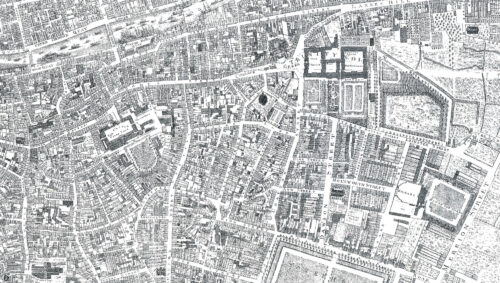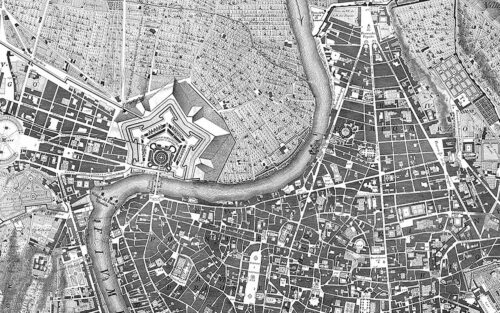Excerpt from "Dublin: Creation, Occupation, Destruction" from forthcoming publication "Dublin: Creation, Occupation, Destruction" by Niall McCullough - Extract from "Creation" chapter, as part of "Aerial - Symposium celebrating Niall McCullough: architect, writer, thinker" on 4th November 2022 at the Provost's House, Trinity College, Dublin.
There is a moment when you see into a city’s heart and begin to understand its nature. My appreciation of Dublin crystallized around the study of old maps. Occasionally, random events enmesh. Living in Rome, the famous 1748 Nolli Map served as a document to explore the city; returning to Dublin, I saw a replica of John Roque’s 1756 map in a bookshop window and bought it out of interest; I did not then know that I would come to use it in the same way, and see it as representative of wider ideas.
Both Nolli and Roque are well-known, but seldom compared. Both are 18th century artefacts, with a sense of the grand scale, orientated North, emblazoned with explanatory cartouches, and presented in a series of separate sheets which, linked together, presented a panoply of the city and its environs. Both were made in the same era by men with a similar arc of existence; both represented cities with apparently disordered plans which were noted for their unity of architectural expression. However, while Nolli still represents some of the reality of Rome; Roque is quite unlike contemporary Dublin; the map has a dream-like character; there are some familiar things - but almost everything has vanished, from the names of lanes and courts, to whole city quarters. If anything subsists, it’s a vague, coarsened version of the plan; re-engagement is, at least in part, a work of creation.
One map represented a renowned city at the heart of Europe, the other the strange flowering of an unvisited place at the remotest edge of it; Roque wrote of its characteristic anonymity ‘If I had given Credit to what I had been told of this City, I should never have had the Pleasure which I have enjoyed in this work. Several Persons had represented this City as not deserving the Attention of Strangers, not being remarkable for any Singularity, nor affording any Thing worthy of the Curiosity of a Traveller’. The maps also define space in distinctive ways; Nolli drew heavily etched urban blocks framing streets and squares; famously, he included the internal plan of major buildings as a part of the public space of the city, creating a continuum representing an open truth about the way Rome worked. Roque’s map was some kind of necessary opposite; he represented Dublin by defining the outline of every single structure in the city, making a plan of closed boxes aligned to form streets. The map has an equality of representation; everything is measured rationally, with a levelling gaze and without excessive hierarchy; houses are the assembled property of individuals, not kings; their repetitive forms make up the streets; everything is owned. Almost despite itself, the map is a manifest work of the Enlightenment. ...
—James Conway, Former Director of English Touring Opera reads from Niall's last book

